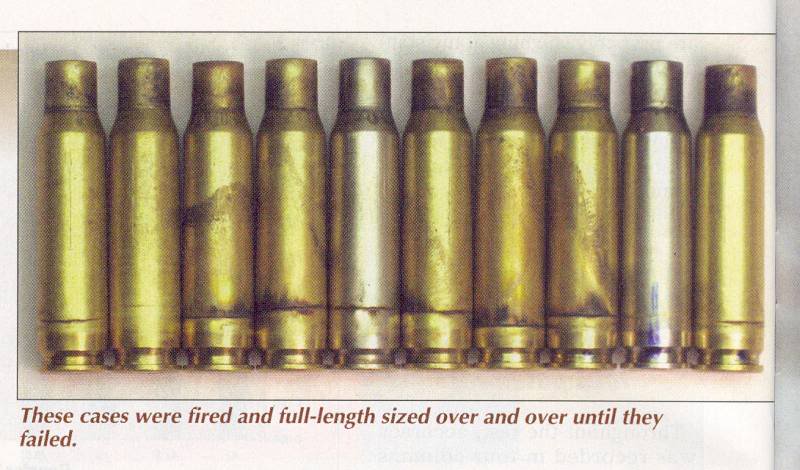-
Advisory Panel


Badger, please consider replacing that version of "Headspace 101 . . ." with the current iteration, which contains some added information and removes the controversial lubed-case approach. (You might also remove the obsolete e-mail address. I have a new one I don't post but can be reached through this board's PM feature.) Thanks.
************************************************** ************************************************
Several generations of American shooters have been convinced by bad information that something mysterious and scary called "headspace" should be checked and re-checked on almost any surplus rifle, especially Lee-Enfields. The truth is less interesting but still worth knowing.
Stripped to its essentials, with a rimmed cartridge like the .303, headspace is simply the distance between the front of the bolt and the back of the barrel. It's the space where the "head" (rim) of the cartridge fits when the rifle is loaded.

Since there has to be some room to allow for varying rim thickness, the headspace is normally a bit more than necessary - giving what I call "head clearance", a little extra space so the bolt can close easily, even on the thickest rim allowed.
In addition, Lee-Enfields and their ammo were often made with a fair amount of space for dirt, mud, snow and other battlefield debris between the chamber and the cartridge's body and shoulder ("Body/shoulder clearance"). Since the cartridge is controlled by its rim, this clearance doesn't do any harm (except to handloaders who insist on full-length sizing).
When a full-power .303 cartridge is fired, a whole string of events occurs.

1. The firing pin shoves the case forward, rim against the breech.
2. The primer detonates. If it's not heavily crimped in place, it backs out, shoving the bolt and barrel as far apart as it can.
3. The thin, forward part of the case expands to fill and grip the chamber while the bullet moves out of the case and down the barrel.
4. The solid case head can't expand and grip the chamber, so it moves rearward, re-seating the primer, stretching the case walls just forward of the head, and stopping when it hits the bolt face. (In rear-locking actions like the Lee, the bolt and receiver also compress/stretch to add a little more movement. The higher the pressure, the more they move.)
5. If (and only if) the amount of head movement exceeds the elastic limits of the case, the cartridge separates into two pieces.
New cartridge cases can normally stretch a lot before breaking. Even with a minimum rim .054" thick and maximum "field" headspace of .074", the resultant .020" head clearance is well within the limits of new brass and it's very unlikely a new case will separate even if the headspace is somewhat more than the field maximum (which is pretty rare).
OK, but if one does separate I'm in deep trouble, right? Not really. It seems the short "cup" left behind the break is pretty good at keeping most of the gas where it belongs. Here's a demonstration -
First I took a case that had been reloaded with heavy loads enough times so it was stretched near breaking.

I loaded it with a 180-grain bullet and 40 grains of 4895 - a reasonably stiff charge about 2 grains under "maximum" - and fired it in a much-abused Savage No.4 with a clean sheet of typing paper wrapped around the receiver.

When I opened the bolt, the separated head extracted. (The front piece of the case fell out when I happened to turn the rifle muzzle-up while removing the paper.)

The sooty paper shows where some gas escaped. No rips or holes, just a little soot - and only where the bolt meets the barrel. Had I been shooting from the shoulder and wearing glasses, I probably wouldn't have noticed the leak at all.
The point of all this is that excess headspace, even a bit beyond normal limits, isn't the terrible danger we've heard so much about. It's not a good thing for consistent ignition or long case life (although handloaders who neck-size or adjust F.L. dies carefully can control this) - but it's not a disaster waiting to happen.
Unless you're consistently getting broken cases when firing new ammo or brass, there's not much reason to be worried about headspace in these sturdy old Lee-Enfields. Relax and enjoy!
Handloading
If you handload for a .303 with generous headspace, there's no need to mess with bolt heads - changing the rifle's clearances to yield longer case life. You can control head clearance simply by changing technique.
When you fire a new case for the first time, use an improvised spacer ahead of the rim - anything from a precision metal washer to dental floss can work to hold the the cartridge head firmly against the bolt face and eliminate or reduce stretch even if head clearance is significant. Another way of accomplishing the same end is to use a bullet seated out far enough to jam into the lands, "headspacing" on the bullet instead of the case. Such techniques are useful only if the rifle has excess headspace. With normal headspace, initial stretch isn't enough to worry about.
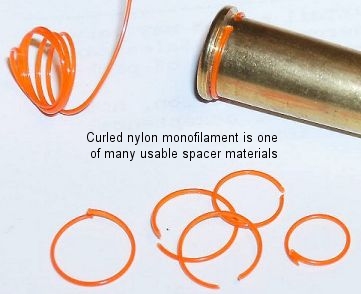
After you've fire-formed your new cases they will fill the chamber fully, stopping on the shoulder just like a rimless cartridge. If you neck size, you'll have zero "headspace". If you have to full length size, adjust the die so the cases chamber with just a bit of resistance in the last few degrees of bolt rotation.
Finally, don't try to turn a .303 into a magnum. Keep the pressures below the limit and you reduce the small amount the bolt and receiver compress/stretch on firing in a rear-locking action.
With these techniques you can make your .303 cases last for dozens of loading cycles, even if your "gauge headspace" is well beyond the .074" field spec.
----------------------------------------------------------------------------------------
To demonstrate how we can control head clearance using only the shoulder, I filed off the rim of a once-fired Remington .303 case. After adding an extractor groove to fit a Mauser-size shellholder, I neck-sized, reloaded and fired this case 19 more times.

The load was a 180-grain jacketed soft-point over a lightly-compressed charge of IMR 4350 (giving an average velocity of 2310 fps for the 19 shots and listed at just under 39,000 CUP in my IMR data booklet). The test rifle was a 1943 Lithgow S.M.L.E. Mk.III*. 20 shots was enough for a practical test, I sectioned the case to examine the web/body junction area where thinning normally occurs.
S.M.L.E. Mk.III*. 20 shots was enough for a practical test, I sectioned the case to examine the web/body junction area where thinning normally occurs.

This case, fired 19 times with no rim, has not stretched or thinned at all. I'm sure it could have continued for at least another 20 of these moderate loads.
It's clear to me that the .303's shoulder, alone without help from the normal rim, is entirely adequate to maintain "headspace" when sized in a way that preserves the shoulder location. Those handloaders who experience poor case life with neck-sized handloads should look for other factors to explain premature case failures. The most likely source of trouble is high pressure. More pressure means more action flex and that means shorter case life.
************************************************** ************************************************
Just to demonstrate that there's nothing new (except computer animation), here's a page from a 1937 book I found online several years after first posting "Headspace 101 . . ."
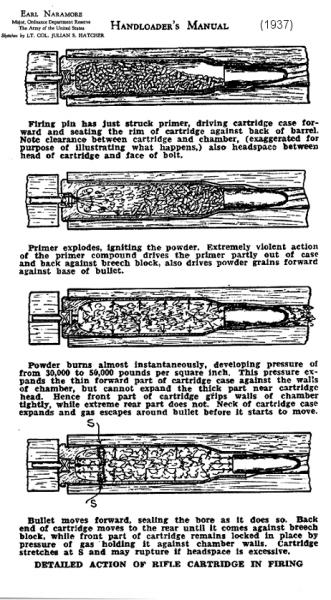
-
The Following 5 Members Say Thank You to Parashooter For This Useful Post:
-
04-30-2009 01:18 PM
# ADS
Friends and Sponsors

-
Banned

The British Enfield Rifle
Enfield Rifle has gotten a bad reputation in regards to headspace that it does not deserve, American made SAAMI designed cartridges have thin rims, small base diameters and are designed for chamber pressures below 43,000 CUP.
has gotten a bad reputation in regards to headspace that it does not deserve, American made SAAMI designed cartridges have thin rims, small base diameters and are designed for chamber pressures below 43,000 CUP.
These American made cases were designed for less headspace and lower pressures levels than the military Enfield was designed to operate at. Privi Partizan cases have thicker rims, and are at least .010 thicker in the base web area than American made cases and remind me of military designed cases which are much thicker in the base area than commercial cases.
Below is a Privi case on the left and a Greek HXP case on the right, the Privi case has a larger and thicker base diameter than the Greek HXP cases and looks far different after being fired in an Enfield rifle. The HXP case pictured after checking over 500 once fired HXP cases did NOT thin or stretch in the web area at all.
The Privi cases remind me of my Lake City Match grade 30-06 cases and are built “Ford Tough” (the Winchester cases are built like a Chevy and fall apart after just a few reloadings)
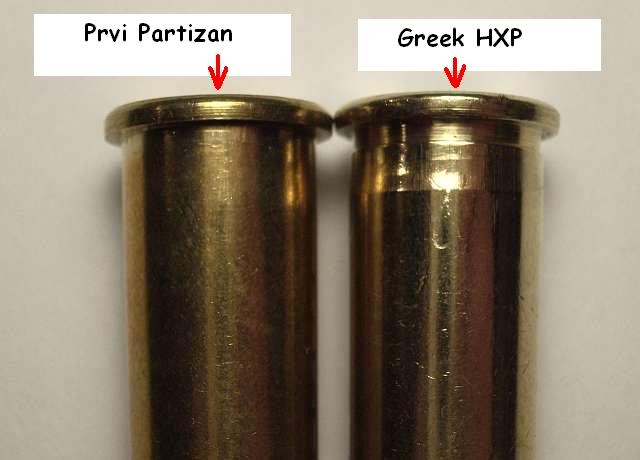
Do not misjudge your headspace by looking at your fired cases, headspace is actually governed by the cases you shoot and not your military specifications for headspace of your Enfield rifle. (You don’t use 13 inch tires for a Toyota on a 18 wheeler truck)
The 2002 Canadian No.4 Enfield manual has headspace settings for what I believe is the use of commercial ammunition in their Canadian Rangers Enfields, AND this is for firing the case once and not reloading it.
No.4 Enfield manual has headspace settings for what I believe is the use of commercial ammunition in their Canadian Rangers Enfields, AND this is for firing the case once and not reloading it.
Headspace is governed by the cases you are shooting and not the specifications written in the British military manuals.
Case in point, below is the Canadian No.4 headspace settings published in 2002.
I read this as:
.064 GO
.070 NO-GO
.074 FIELD

Below is a Winchester case and it is .020 thinner in the web area than the Privi case below it.

Privi case built Ford tough 

Also this idea came from our old Jouster forum and was submitted by a Canadian member, he used rubber o-rings to fire form his cases which pushed the cases up against the bolt face and prevents case stretching and thinning in the web area. After the first firing or fire forming the cases then headspace on the shoulder of the case.
forum and was submitted by a Canadian member, he used rubber o-rings to fire form his cases which pushed the cases up against the bolt face and prevents case stretching and thinning in the web area. After the first firing or fire forming the cases then headspace on the shoulder of the case.


Below is a factory loaded Winchester case that was fired in my 1943 Maltby with the headspace set at .067, this case thinned and stretched .009 (nine thousandths) in the critical web area. The head gap clearance or the distance from the rear of the case to the bolt face on this case is .009(nine thousandths) how much do you think the case would thin and stretch if the headspace was set at .074?
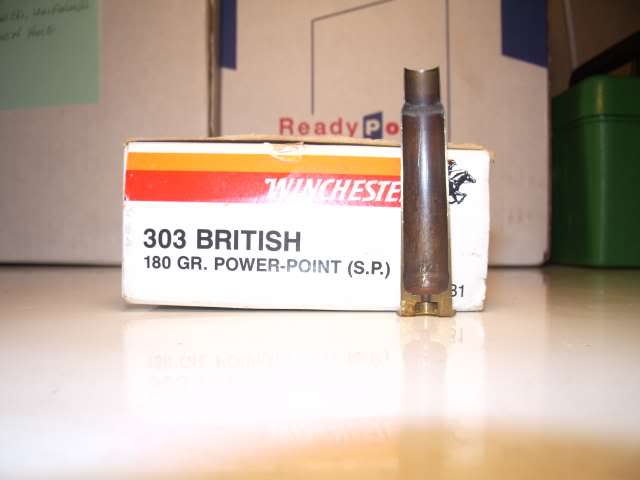
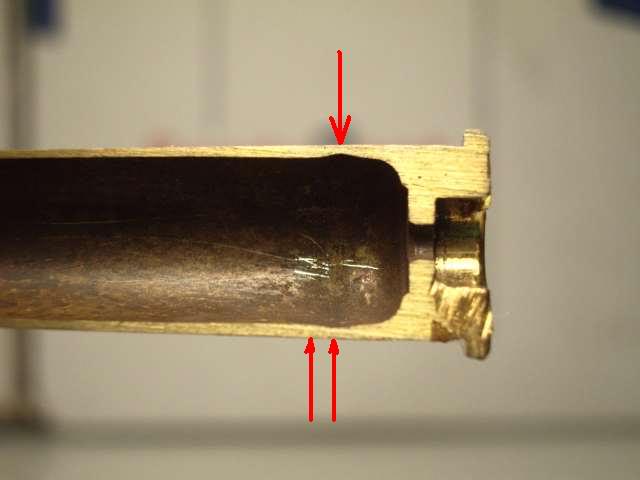
The quality of your cases makes all the difference in the world when you are reloading, if you do not reload then headspace set at .074 should not cause any problems in a properly maintained Enfield rifle.
Please note this post is not intended to take anything away from Mr. Parashooters very well written headspace 101 or insult Mr. Parashooter in any way.
( I hit the post button and saw Mr. Parashooter was here before me and wish to make my posting clear to all)
Last edited by Edward Horton; 04-30-2009 at 02:01 PM.
-


Originally Posted by
Parashooter

Badger, please consider replacing that version of "Headspace 101 . . ." with the current iteration, which contains some added information and removes the controversial lubed-case approach. (You might also remove the obsolete e-mail address. I have a new one I don't post but can be reached through this board's PM feature.) Thanks.
Roger that .... 
Will do over the weekend as I'm currently traveling on business....
Thanks for the heads up...
Regards,
Badger
-
-
FREE MEMBER
NO Posting or PM's Allowed

I agree with almost all of the above except...
Those "tricks" (I liked the use of monofilament line) will work to a point, and will at least temporarily prevent case stretching and separation. But if the rifle is fired enough, a point will come where excess headspace will allow the case to back out of the chamber far enough that the thinner part of the case will not be supported, and the result will be damage to the rifle and possible injury to the shooter. The recommendations only delay, they do not prevent, severe damage.
If the locking lug seats in the receiver (body) are so badly battered that they result in excess headspace to the point of case separation, it is time to retire that receiver. Any of those "techniques" will only delay the inevitable and give the shooter a false idea that he has "fixed" the headspace and can continue shooting the rifle indefinitely . He might find out the hard way that the "fix" doesn't work.
Jim
-
Banned

-
Advisory Panel



Originally Posted by
Jim K

. . . if the rifle is fired enough, a point will come where excess headspace will allow the case to back out of the chamber far enough that the thinner part of the case will not be supported, and the result will be damage to the rifle and possible injury to the shooter. . .
That's conceivable, but the rifle has to be very badly buggered for the case head to back out far enough to even approach the front end of the solid head. As can be seen in the image below (of once-fired Berdan and much-fired Boxer cases), a whopping .060" excess (beyond the .070" "SAAMI field" limit) gets the case only as far as the end of the primer pocket at .130" from the bolt face. Something has to be terribly wrong for a Lee-Enfield to "develop" that much excess - lugs filed down, barrel backed out, receiver broken, burned in a fire, welded, etc. Lots of ways to screw up a rifle, but not likely to happen from several lifetimes of normal firing, I suspect.
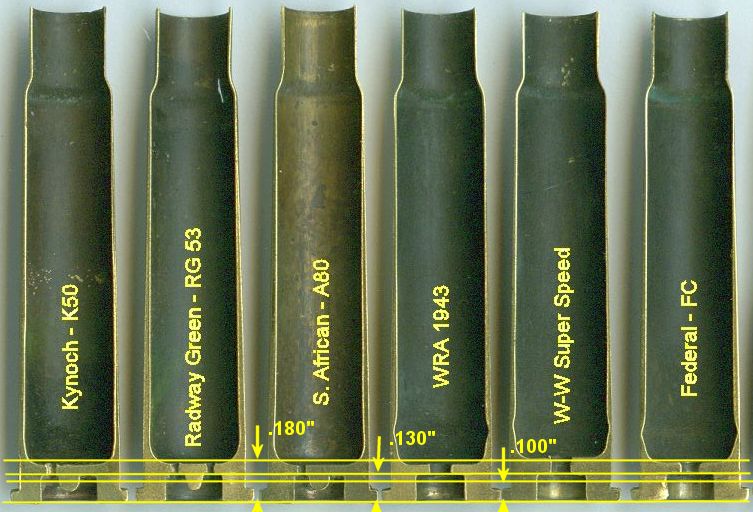
Mr. Horton - Am I suffering from an "optical delusion" or did you measure those case walls at a different distance from the base?
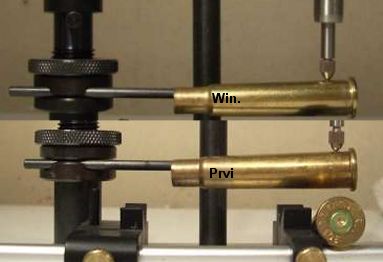
What results would we see if compared at the same place?
-
-
Banned

-
Advisory Panel


Thanks, Ed. I think your latest set of pictures, showing the W-W and R-P cases at ~.030", might be a more accurate reflection of the situation than the one showing the W-W case, farther forward, at .020".
Prvi may have a proclivity for heavy walls. They made the GRAF case shown here - much thicker sidewalls (but thinner web) than the W-W .348 -
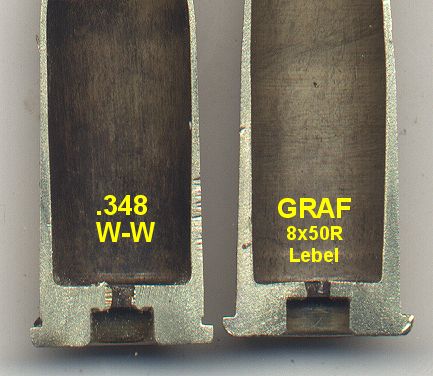
Have you sectioned any of the Prvi .303's?
-
-
Banned

-
FREE MEMBER
NO Posting or PM's Allowed

The determination of a potential problem is not the thickness of the rim but the depth (or height if you prefer) of the base. The further heavy brass extends into the case, the better the case will stand excess headspace. And that is part of the trouble here. The assumption by some seems to be that if case brand "X" will not burst with a headspace of "Y", then a headspace of "Y" is safe, no matter what those silly old gauges say.
Headspace is actually of more concern to the military than to civilians. If a case separates in a civilian rifle, the worst that will usually happen is a trip to the gunsmith or watching a prize deer depart for safer places. If that happens in a military rifle, the soldier may well be killed. But that does not mean that it can be ignored by civilians or that neat ways to bypass excess headspace are good ideas.
The Rifle No. 1 (incl. SMLE) has another area of concern. Due to its rear locking lugs, when subjected to high pressure, it will "spring", the receiver actually bending so the bolt head pulls away from the barrel breech. This happens in an instant and in most cases the receiver springs back and leaves little sign of what happened except a blown case, a ruined magazine, and usually a departed extractor. But some damage remains, and excess headspace is usually part of it. This does not happen (or I have never known it to happen) with a No.4, which has a stronger receiver.
Jim







S.M.L.E. Mk.III*. 20 shots was enough for a practical test, I sectioned the case to examine the web/body junction area where thinning normally occurs.

















 PM
PM


















